SEJournal Online is the digital news magazine of the Society of Environmental Journalists. Learn more about SEJournal Online, including submission, subscription and advertising information.
 |
| The full range of the Papahānaumokuākea Marine National Monument in the remote northwestern Hawaiian Islands, where Nathan and Alana Eagle traveled to produce “The Last Wild Place.” Illustration: Courtesy of Honolulu Civil Beat. Click to enlarge. |
EJ InSight: On Remote Hawaiian Islands, Seeing What Few Ever See
By Nathan Eagle
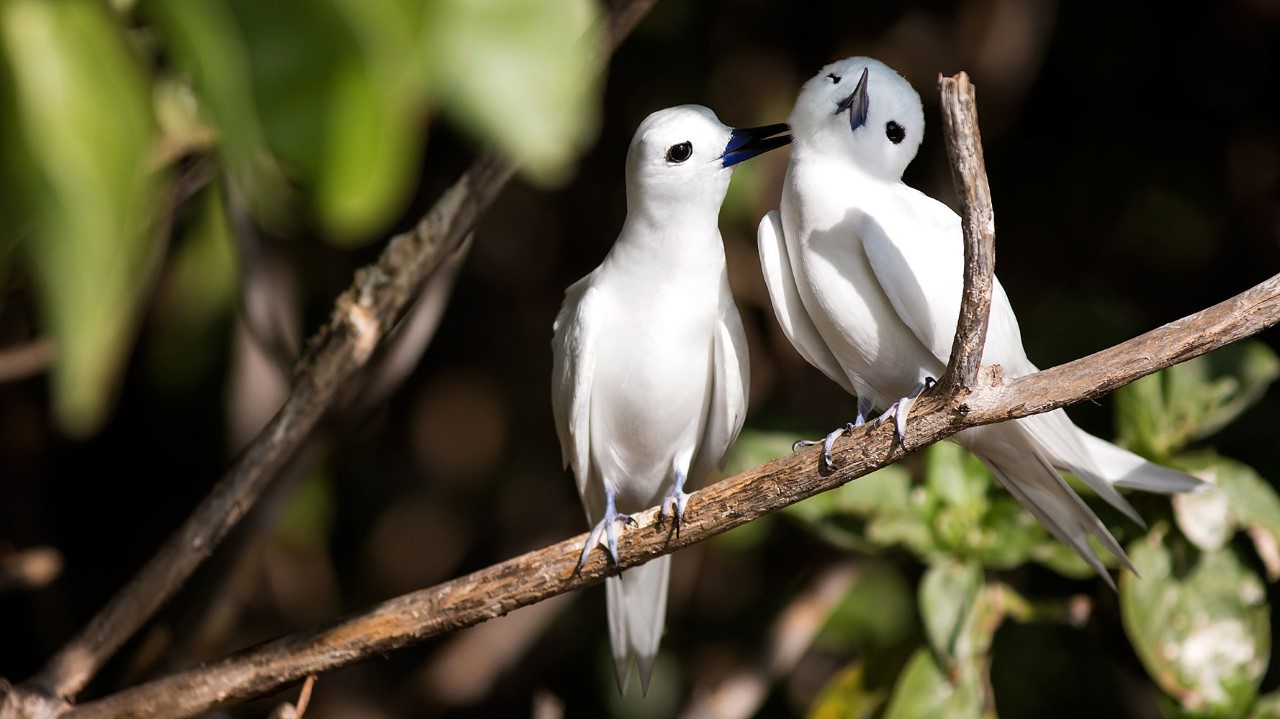 |
| White terns grooming one another on Laysan Island, part of Papahānaumokuākea Marine National Monument. Photo: © Nathan Eagle, Honolulu Civil Beat. Click to enlarge. |
I had never frozen new underwear before.
But that’s exactly what I had to do when packing a few five-gallon buckets with clothes and gear for two weeks of reporting in Papahānaumokuākea Marine National Monument in the remote northwestern Hawaiian Islands.
The biosecurity measures help prevent invasive insects from hitchhiking there, where they can decimate native ecosystems that scientists and volunteers have spent decades working to restore.
A tiny bug can be a huge problem. Yellow crazy ants, for instance, blind petrels by spraying acid into their eyes.
As a reporter for Honolulu Civil Beat, I’d written for several years about the monument — created by President George W. Bush in 2006 — as stories came across my desk.
Those pieces mostly focused on new species scientists were discovering there, or the incredible amount of marine debris littering an otherwise pristine place — bottles, lighters, tires, etc. that drift in from thousands of miles away.
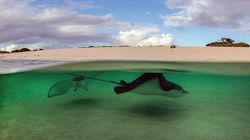 |
| Eagle rays in the shallows just offshore of Laysan Island. Photo: © Alana Eagle, Honolulu Civil Beat. Click to enlarge. |
But I honed my focus on the monument as controversy started to swirl over its proposed fourfold expansion in 2016.
Environmentalists were overjoyed by a bigger sanctuary for native wildlife, deepwater corals and unexplored ocean.
But commercial fishermen were furious about losing tuna grounds, and lobbied then-President Barack Obama to deny the expansion, officially proposed by Sen. Brian Schatz, D-Hawaii, based on a request from seven Native Hawaiians.
Like past presidents, Obama ultimately decided to exercise his executive authority to create what was at the time the world’s largest protected natural place.
 |
| Nathan Eagle temporarily serving as a perch for a booby on Laysan Island. Photo: © Alana Eagle, Honolulu Civil Beat. Click to enlarge. |
Armed with gear for immersive storytelling
There’s no substitute for firsthand reporting, and sources had for years shared leads to a litany of stories. I wanted to go, but the monument’s 583,000 square miles are generally off limits to all but scientists, cultural practitioners and a handful of others who, with special permission, visit to study the place and return it to its natural state.
But eight months after submitting a 29-page application in 2017, I was able to secure an education permit from the monument’s four co-managers — the National Oceanic and Atmospheric Administration, U.S. Fish and Wildlife Service, Hawaii Department of Land and Natural Resources, and Office of Hawaiian Affairs. It covered both me and my wife, Alana Eagle, who was a freelance videographer and underwater photographer for Civil Beat at the time.
 |
| Alana Eagle going over her gear aboard the M/V Kahana enroute to Papahānaumokuākea. Photo: © Nathan Eagle, Honolulu Civil Beat. Click to enlarge. |
My background is in print journalism, but I’ve gotten handy with a camera, driven by both personal interest and wanting to shore up gaps in short-staffed newsrooms. So I went armed with not only pens and notebooks, but also a Canon 7D and the two lenses I used most — a 100-400mm F/4.5 and a 70-200mm F/2.8.
Alana has a film background and a passion for underwater photography. She was ready with her Canon 80D, with Ikelite waterproof housing, and favorite lenses — a 10-17mm wide angle, a versatile 18-135mm zoom and a reliable 50mm.
To make the most of this rare opportunity, we added an underwater Nikon 360 camera so we could experiment with more immersive storytelling techniques, and took professional audio equipment to use in podcasts and add aural elements for still-photo stories.
Rolling with the reporting
Loaded down with all our gear, we traveled 1,300 miles over the course of two weeks in an old freight ship from Oahu to the last speck of land in the Hawaiian Archipelago, stopping at Laysan Island, Kure Atoll and Midway before flying back to Honolulu.
The M/V Kahana was taking a relief team of state conservation workers and a half dozen volunteers to the tiny atoll of Kure, where they’d spend the next six months continuing restoration efforts and surveying seabirds.
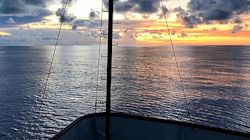 |
| At dawn, the M/V Kahana approaches Kure Atoll, “the last speck of land in the Hawaiian Archipelago," over 1,300 miles northwest of Honolulu. Photo: © Nathan Eagle, Honolulu Civil Beat. Click to enlarge. |
Alana and I packed our gear in a couple of backpacks and the four buckets mentioned earlier — two for Kure and two for Laysan. Both are quarantine islands, which means anything soft — underwear, clothes, shoes, camera straps, backpacks, hats — needs to be purchased new, and then frozen by the agency for at least 48 hours prior to departure to prevent the spread of invasive species. Expensive for us, even shopping at discount stores, but worth it.
Immediately prior to arriving, you crack open the bucket and change into your quarantined clothes before stepping foot on either island (Midway did not require the same level of biosecurity).
The sun is relentless, which meant lightweight, breathable pants, moisture-wicking shirts, thin long-sleeved jackets, hats, sunglasses and Crocs, which everyone had recommended and we reluctantly grew to love.
Our days began before sunrise with an intentionally loose plan. We wanted to be able to roll with whatever opportunity arose, like unexpected treks with resource managers monitoring one of the world’s rarest ducks, the Laysan teal, or field trips with scientists studying the endangered Nihoa millerbird, only found in these remote islands.
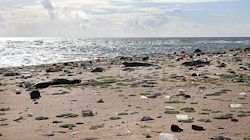 |
| Critically endangered Hawaiian monk seals on a beach amidst marine debris washed up on Laysan Island, where “fishing nets, whiskey bottles, lighters, tires and even car seats drift in from thousands of miles away." Photo: © Alana Eagle, Honolulu Civil Beat. Click to enlarge. |
Each night was a sleepy downloading party in the galley. Pulling files from memory cards, backing up everything on external hard drives, charging batteries and taking notes in our daily logs while enjoying ice cream from the ship’s freezer.
On Laysan, a 1,000-acre island just a few feet above sea level, we slept in tents and charged our gear with a solar-powered Goal Zero Yeti. It made for two absolutely unforgettable days and nights.
Decades of conservation work has made Laysan one of the “crown jewels” of the northwestern Hawaiian Islands. When we visited, an 11-member U.S. Fish and Wildlife Service crew were demobilizing the semi-permanent camp that the agency had maintained there for the past 20 years. There was an emphatic leave-no-trace practice (except for what was left in the open-air outhouse). Henceforth, people will only go ashore there for scientific research, marine debris removal or cultural practices.
Post-it epiphany leads to visual organization
We initially envisioned coming back with enough material for a comprehensive three-part series, neatly broken into the environmental, historical and cultural aspects. But we decided that that approach would exclude much of the visual material we had primarily set out to capture.
Inspired by successful multimedia projects
other newsrooms had done, we wanted to try
to upgrade Civil Beat’s visual journalism to maximize
our photos, videos and audio with relatively limited resources.
Inspired by successful multimedia projects other newsrooms had done, we wanted to try to upgrade Civil Beat’s visual journalism to maximize our photos, videos and audio with relatively limited resources.
With that aim nailed down, Alana and I faced the daunting task of putting together all the main elements. Each island has its own unique history, culture, flora and fauna, challenges and solutions. And I had additional reporting to do on the islands we didn’t visit, as well as those we did. Though we’re both visual people, we just weren’t seeing the project take shape.
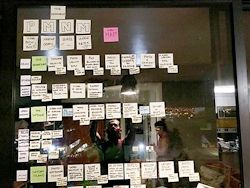 |
| Alana Eagle's "Post-It Epiphany” on a window of their Honolulu home helped them organize the multiple media elements of their journey. Photo: © Nathan Eagle, Honolulu Civil Beat. Click to enlarge. |
That changed with a major breakthrough working late one night at home — Alana’s Post-it Notes epiphany. Organizing the project into chapters, we stuck color-coded Post-its all over our windows with notes about what each part would contain. A still photo here, a video explainer there.
From that, I was able to select the photos to tell each island’s story and shore up any reporting holes, while Alana went into marathon video-editing sessions.
For weeks, we worked on it from when we woke up until late into the night to meet internal deadlines. Meanwhile, the design team was figuring out how to make it all work on the back end. Some edits here, a couple tweaks there, and “The Last Wild Place” eventually came together.
The project went on to win first-place awards from Editor & Publisher, the Asian American Journalists Association, the Society of Professional Journalists and the Society of Features Journalism, as well as honors from the Society of Environmental Journalists.
A couple of nonprofits also recognized us, including the Audubon Society and Friends of Hanauma Bay, and we were invited to share our project with schools and community groups. The recognition told us this type of story really connected with people.
The public response to the project inspired a return last year to French Frigate Shoals in the Papahānaumokuākea Marine National Monument with a group of shark and climate scientists. I got stuck covering the state governor’s race, but Alana had a great two-week trip and produced another multimedia project called “The Shark Chasers.”
The once-quarantined gear from both trips has been put to use back home, either for gardening or beach days with friends. And we’ve still got our five-gallon buckets, all ready to be packed for the next reporting adventure in the Pacific, or beyond.
Nathan Eagle covers climate change, politics and ocean issues as an award-winning reporter and photographer for Honolulu Civil Beat. He served as environmental reporter and later the managing editor of The Garden Island daily newspaper on Kauai before moving to Oahu in 2012 to work for Civil Beat.
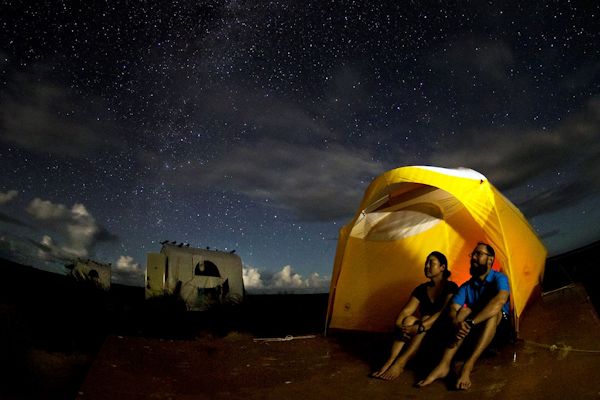 |
| On 1,000-acre Laysan Island, journalists Nathan and Alana Eagle camped ashore just a few feet above sea level during “two absolutely unforgettable days." The resulting project, “The Last Wild Place,” won numerous accolades Photo: © Nathan Eagle, Honolulu Civil Beat. Click to enlarge. |
* From the weekly news magazine SEJournal Online, Vol. 4, No. 30. Content from each new issue of SEJournal Online is available to the public via the SEJournal Online main page. Subscribe to the e-newsletter here. And see past issues of the SEJournal archived here.













 Advertisement
Advertisement 



